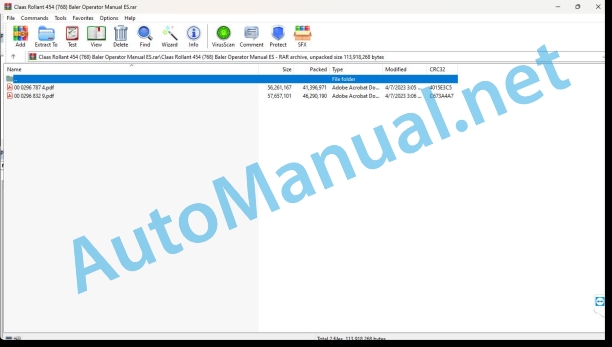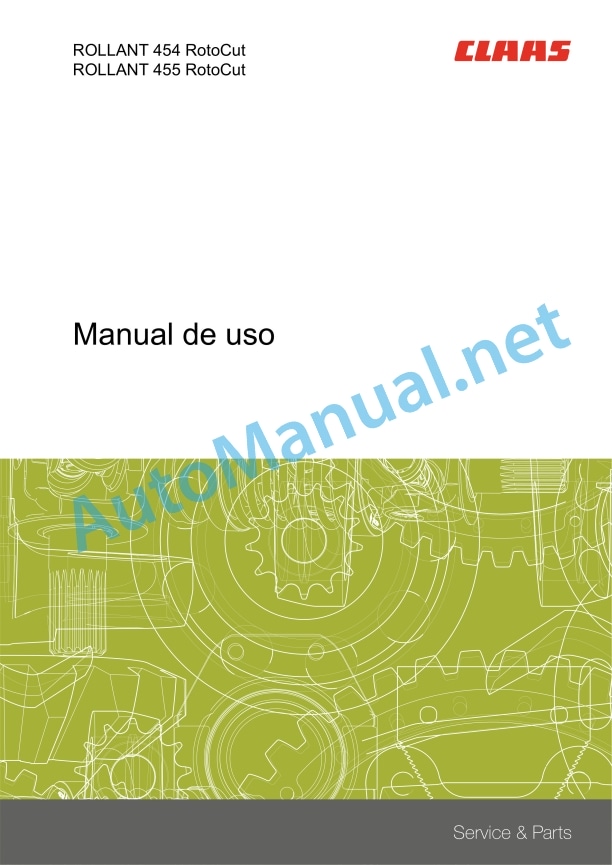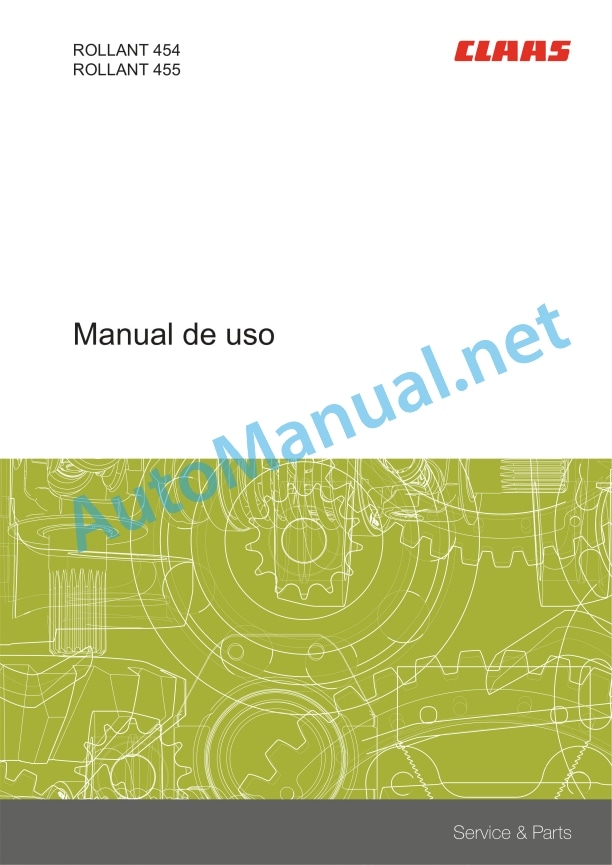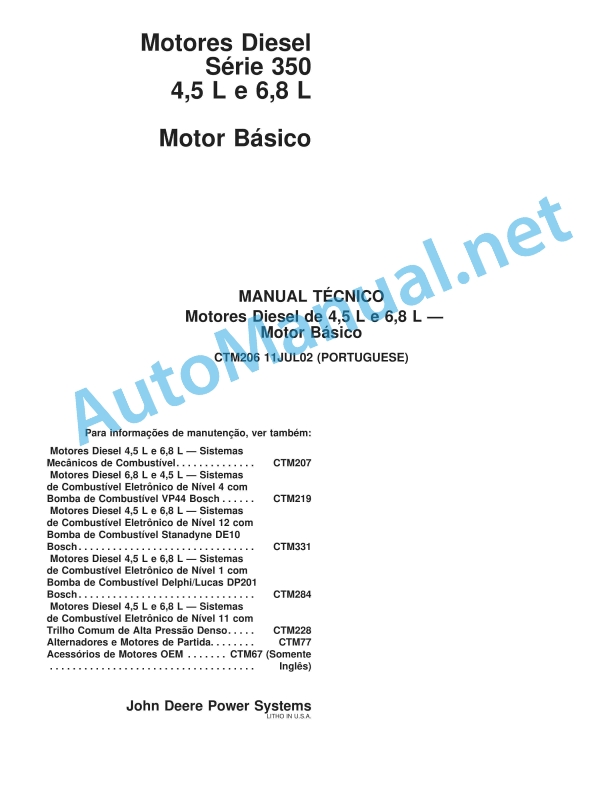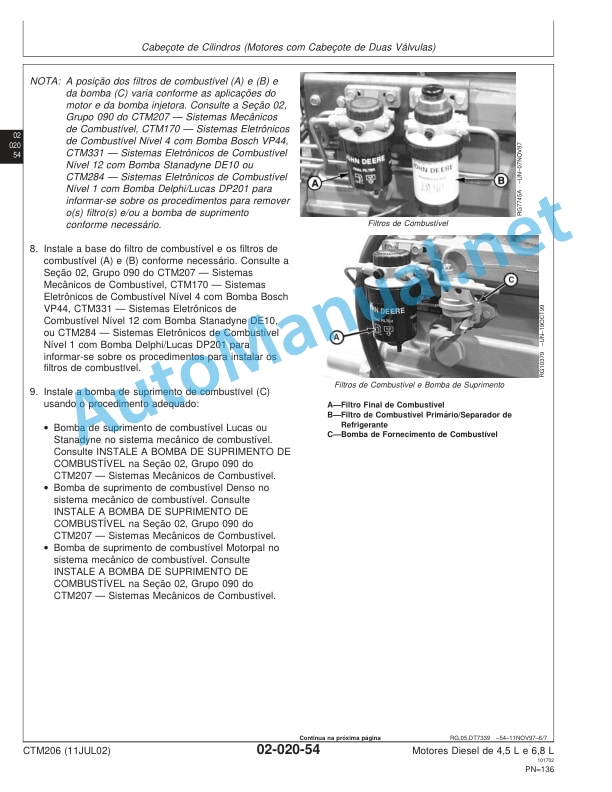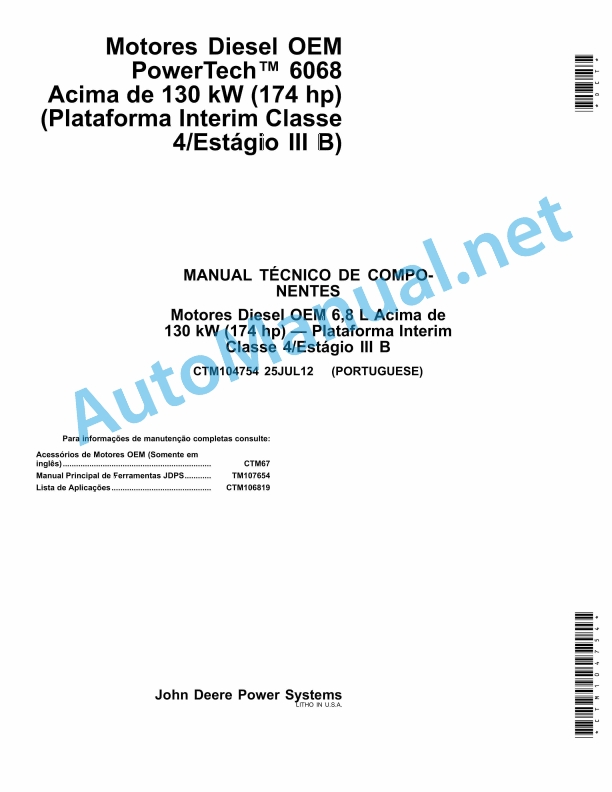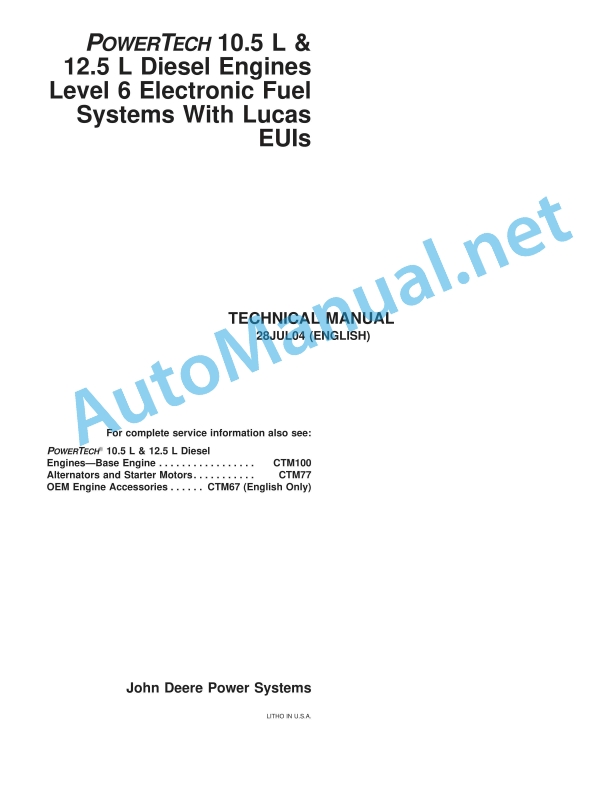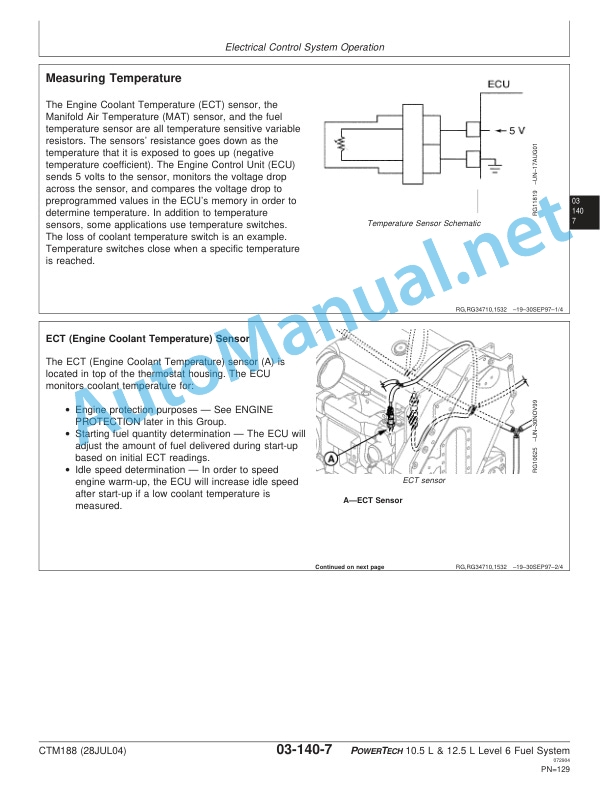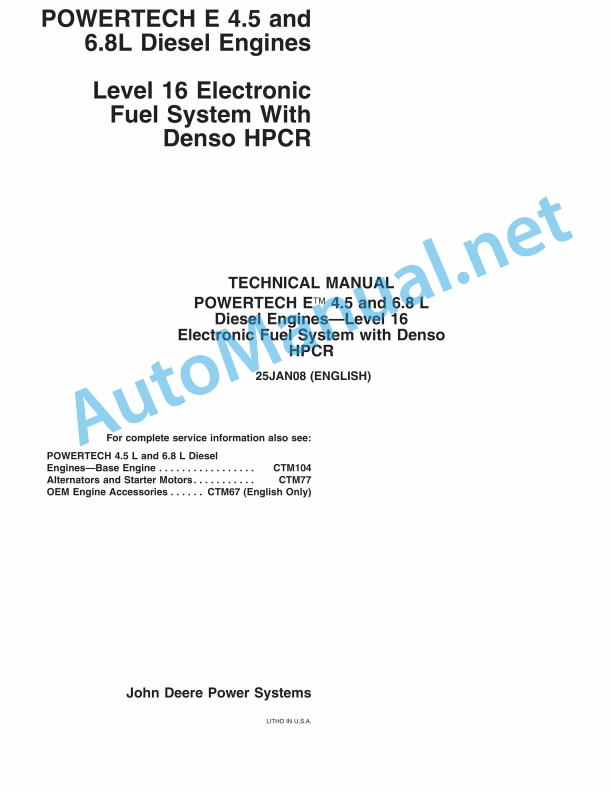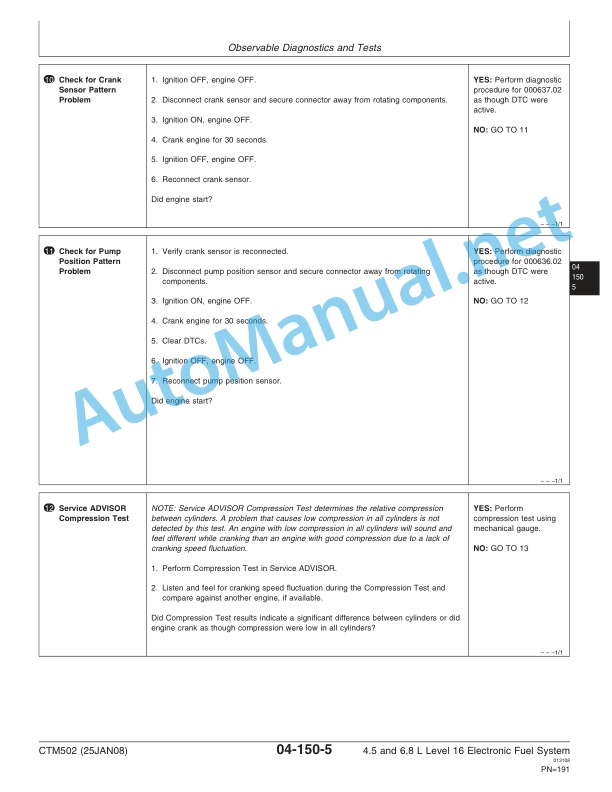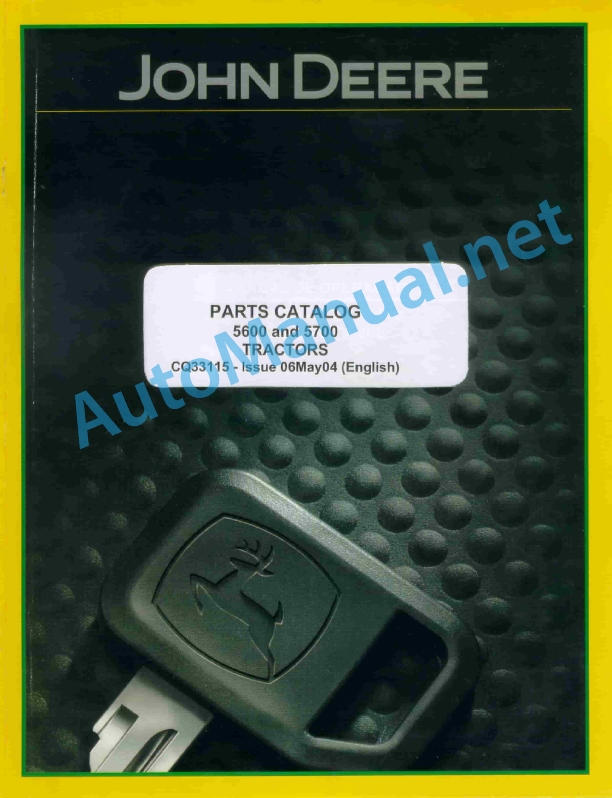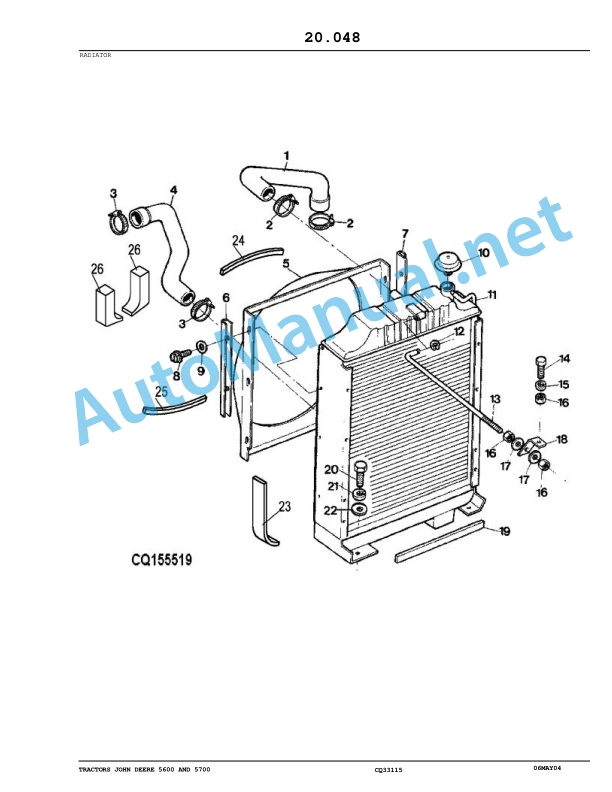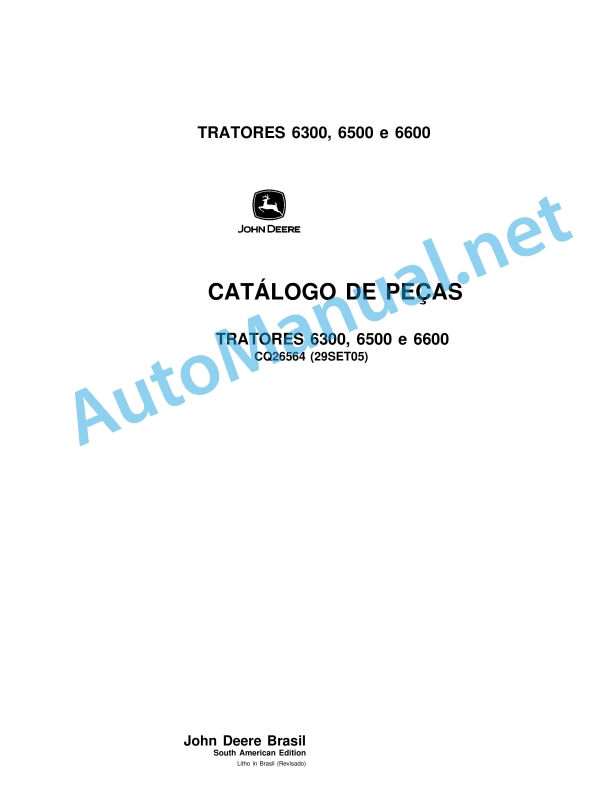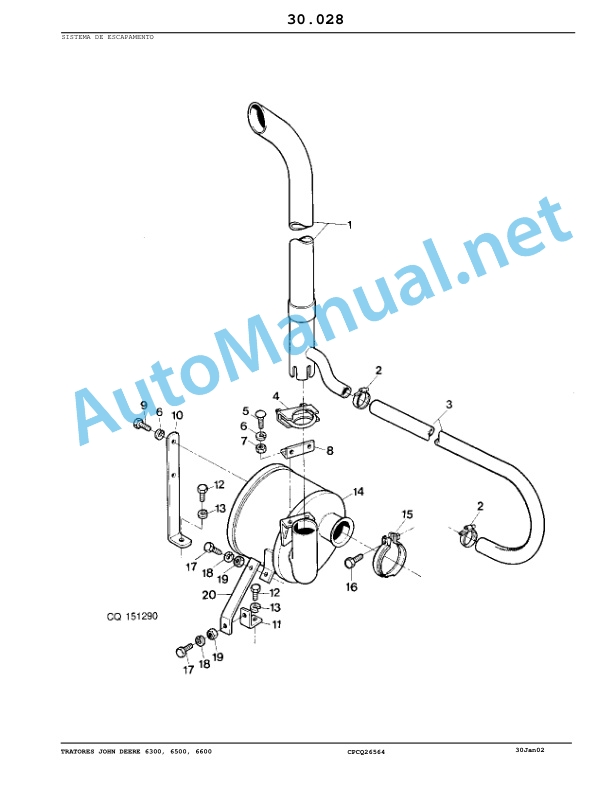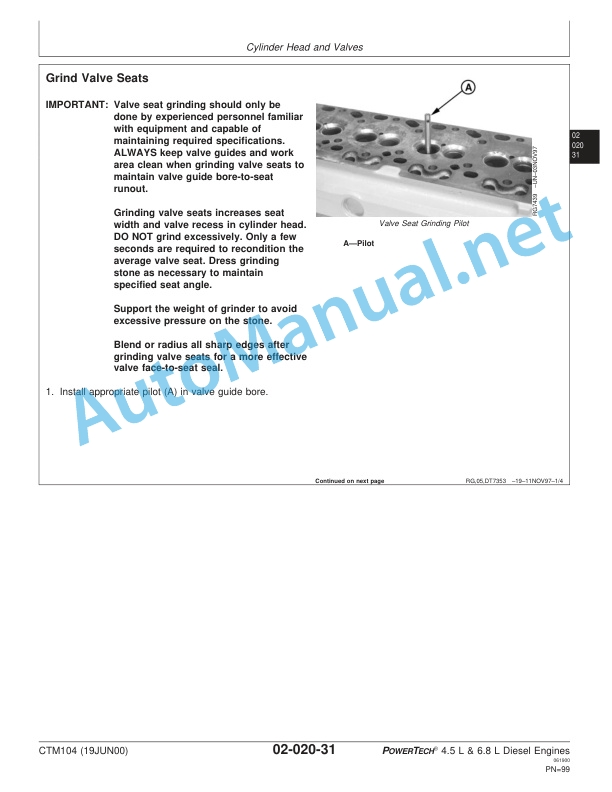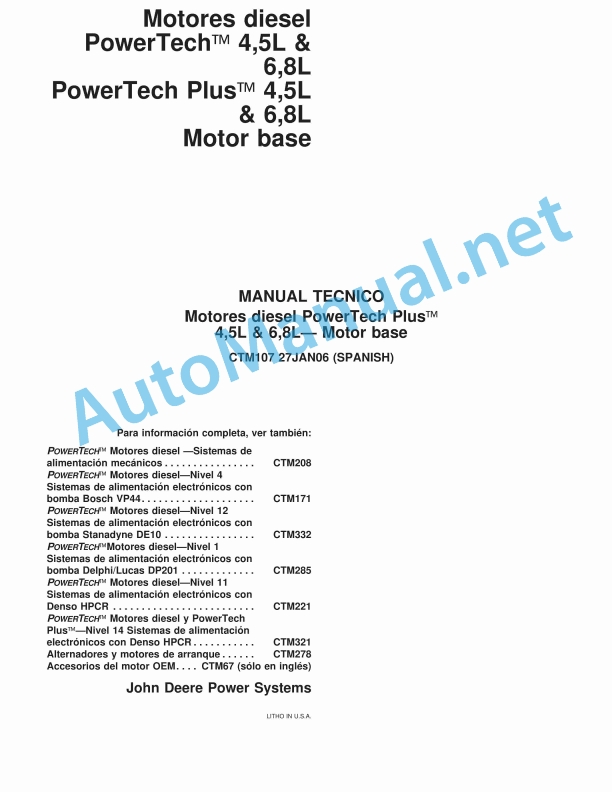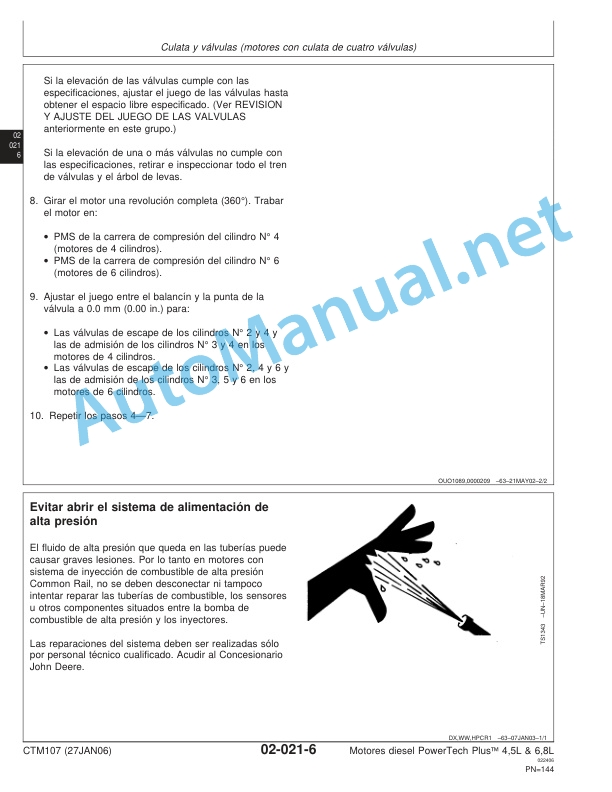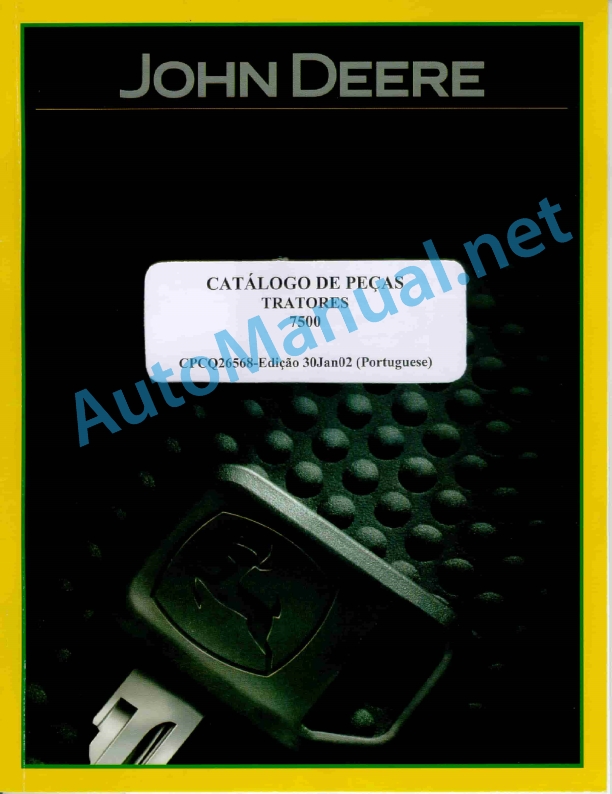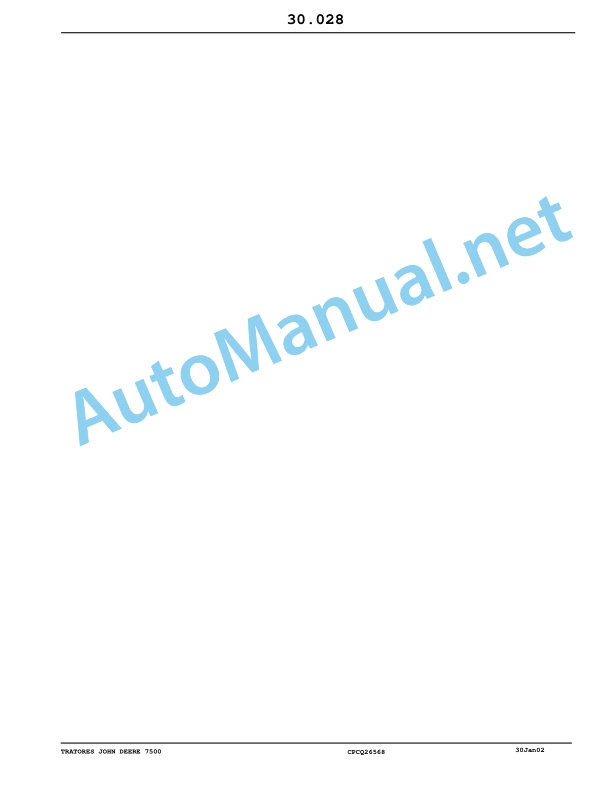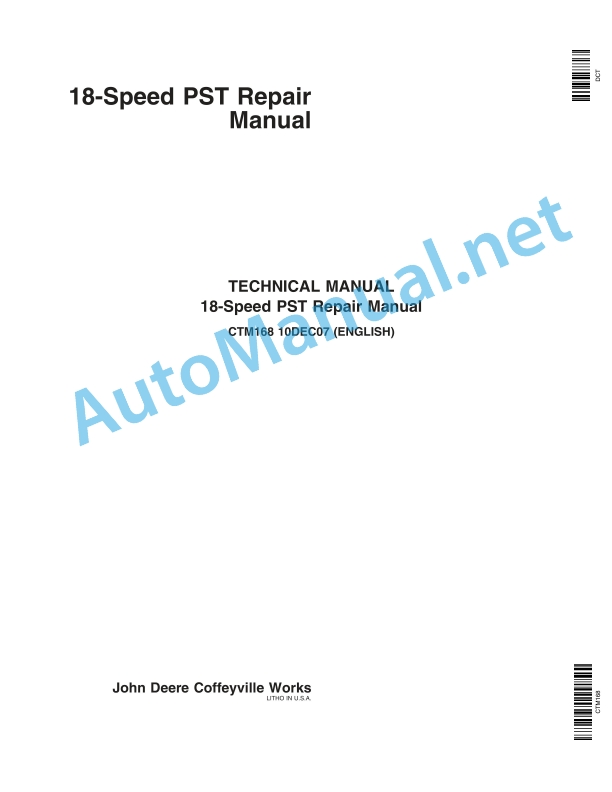Claas Rollant 454 (768) Baler Operator Manual ES
$50.00
- Model: Rollant 454 (768) Baler
- Type Of Manual: Operator Manual
- Language: ES
- Format: PDF(s)
- Size: 83.6 MB
File List:
00 0296 787 4.pdf
00 0296 832 9.pdf
00 0296 787 4.pdf:
ROLLANT 454 RotoCutROLLANT 455 RotoCut
1 Regarding this instruction manual
1.1 General data
1.1.1 Application of this manual
1.1.2 About this user manual
1.1.3 Technical characteristics
2 Security
2.1 General data
2.1.1 General information
2.1.2 Authorized use
2.1.3 Reasonably foreseeable misuse
2.1.4 Highway driving
2.1.5 Symbols applicable to danger indications
2.1.6 Safety regulations
2.1.7 Accident prevention
2.1.8 Waste disposal
2.1.9 Residual risks
2.2 Security stickers
2.2.1 Description
2.2.2 Location of safety stickers
2.3 Safety equipment
2.3.1 Signal lighting
2.3.2 Reflective equipment
2.3.3 Shims
2.3.4 Holding cable (machine not equipped with brake and usable in France)
2.3.5 Parking brake
2.3.6 Surety
2.3.7 Tailgate lock
2.3.8 Locking the pick-up
2.3.9 Fire extinguisher
3 Machine Description
3.1 Existing models
3.1.1 Designation of machines
3.2 Overview and functions
3.2.1 Left side
3.2.2 Right side
3.2.3 Identification of the rollers
3.3 Work and service positions
3.3.1 General information
3.3.2 Top of the baler
3.4 Identification plate and serial number
3.4.1 Spare parts and technical information
3.4.2 Position of the nameplates
3.4.3 Machine nameplate
3.4.4 Rudder nameplate
3.5 General operating principle
3.5.1 Bale pressing cycle
3.6 Control terminal
3.6.1 Control terminal
3.6.2 ISOBUS connection
3.7 Transmission and drive
3.7.1 Power transmission
3.7.2 Main drive
3.7.3 Pick-up drive
3.7.4 Rotor drive
3.7.5 Drive Chains
3.8 Reception of the harvest
3.8.1 Pick-up
3.8.2 Compactor
3.8.3 Short straw plank (optional)
3.8.4 Reducer roller (optional)
3.9 Power set
3.9.1 RotoCut cutting device
3.9.2 Automatic deactivation of the knives at the end of the bale
3.9.3 Unclogging the rotor
3.10 Pressing system
3.10.1 Pressing chamber and rollers
3.10.2 Pressing cycle
3.10.3 MPS (Maximum Pressure System or oscillating segment) hydraulically operated
3.11 Tying system
3.11.1 Tying categories and types
3.11.2 Comfort binding
3.11.3 Tying adjustment
3.11.4 Mesh reserve
3.11.5 Mesh compartment
3.11.6 Electric mesh brake
3.12 Unloading bales
3.12.1 Bale exit ramp
Use without bale exit ramp
3.13 Centralized lubrication
3.13.1 General information
3.13.2 Automatic chain lubrication
3.13.3 Manual centralized lubrication (option)
3.13.4 Mechanical automatic centralized lubrication (option)
3.13.5 Electric automatic centralized lubrication (option)
3.14 Brake
3.14.1 General information
3.14.2 Hydraulic braking
3.14.3 Active hydraulic braking
3.14.4 Pneumatic braking
3.15 Hydraulic system
3.15.1 Baler Hydraulic Block
3.15.2 Continuous hydraulic circulation
3.15.3 Load-Sensing (option)
3.16 Equipment
3.16.1 Ladder
3.16.2 Stirrup
3.16.3 Electronic module
3.16.4 Pressure gauge
4 Control and display instruments
4.1 CLAAS COMMUNICATOR
4.1.1 Presentation
4.1.2 General information
4.1.3 Screen
4.1.4 Key identification
4.1.5 Description of the CLAAS COMMUNICATOR General menu
4.1.6 Description of the CLAAS COMMUNICATOR Using menus
4.1.7 Description of the CLAAS COMMUNICATOR Service menu
4.2 ISOBUS terminal
4.2.1 Presentation
4.2.2 General information
5 Technical data
5.1 Baler
5.1.1 Dimensions
5.1.2 Weight
5.1.3 Hookup
5.1.4 Cardan shaft
5.1.5 Feeding and pressing
5.1.6 Tying device
5.1.7 Wheels
5.1.8 Braking
5.1.9 Hydraulic circuit
5.1.10 Greasing and lubrication
5.1.11 Screw tightening torques
5.1.12 Sound levels
5.2 Safety devices
5.2.1 Security screw
5.2.2 Torque limiter
5.3 Tractor
5.3.1 Required power
5.3.2 Hooking
5.3.3 PTO
5.3.4 Electrical connections
5.3.5 Hydraulic connections
5.3.6 Hydraulic circuit and oil
5.3.7 Braking
6 Preparation of the machine
6.1 General data
6.1.1 First commissioning
6.1.2 Equipment control
6.2 Axis
6.2.1 Position of the axle shafts
6.2.2 Change of position of the axle shafts
6.3 Cardan shaft
6.3.1 Safety regulations
6.3.2 Cardan shaft adjustment
6.3.3 Adaptation of the cardan shaft length
6.3.4 Placing the cardan shaft
6.4 Trailer support
6.4.1 Recommendations
6.4.2 Types of fixing
6.4.3 Adaptation of the fork hitch/oscillating bar hitch
6.4.4 Placing the cardan shaft
6.4.5 Holding cable (machine not equipped with brake and usable in France)
6.5 Hydraulic connections
6.5.1 Machine not equipped with Load-Sensing
6.5.2 Machine equipped with Load-Sensing and tractor with Load-Sensing sockets
6.5.3 Machine equipped with Load-Sensing and tractor without Load-Sensing sockets
6.6 Electrical connections
6.6.1 Marking of electrical cables
6.6.2 Lighting
6.6.3 Battery cable (optional)
6.6.4 Baler power supply with ISOBUS cable
6.6.5 Power supply to the baler and CLAAS COMMUNICATOR
6.7 Brake
6.7.1 Hydraulic brake
6.7.2 Active hydraulic brake
6.7.3 Air brake
6.8 Tying with mesh
6.8.1 Mesh installation
6.8.2 Mesh roll brake adjustment
6.9 Cutting device
6.9.1 Safety regulations
6.9.2 Control
6.9.3 Placing the blades
6.9.4 Assembly of false blades (optional)
6.9.5 Unused blades and false blades
6.10 Pressing chamber
6.10.1 Setting the pressing pressure
6.10.2 MPS adjustment
6.11 Unloading bales
6.11.1 General information
6.11.2 Assembly of the bale exit ramp
6.12 Machine loading
6.12.1 Baler stowage
6.12.2 Lifting points
6.12.3 Elevation
7 Management
7.1 General data
7.1.1 Baler user
7.1.2 Side gates
7.2 Movements with the baler
7.2.1 Equipment control
7.2.2 Preparations for transportation
7.2.3 Road travel
7.2.4 Arrival at the field
7.2.5 Moving around the field
7.2.6 Parking
7.3 Before each use
7.3.1 Cardan shaft
7.3.2 Reminders
7.3.3 Baler maintenance
7.3.4 Equipment control
7.4 Commissioning in the field
7.4.1 Usage tips
7.4.2 Commissioning of the machine
7.4.3 Hydraulic block bypass
7.5 Pick-up
7.5.1 Important
7.5.2 Pick-up wheels
7.5.3 Pick-up height
7.5.4 Compactor
7.5.5 Reducing rollers
7.6 Tied
7.6.1 Bale adjustments
7.7 Bale parameters
7.7.1 Bale adjustments
7.8 CLAAS COMMUNICATOR
7.8.1 Counters Menu
Farm selection and adjustments
Farm selection
Setting the farm name
Using virtual keyboard functions
New exploitation
New work day
Continuation of a task on a farm
Maintenance indicator
7.8.2 Usage parameter settings
Settings
Number of mesh turns
Adjustment
Tying time
Adjustment
Mesh brake force
Adjustment
Interval between two lubrications (machines equipped with electric lubrication)
Adjustment
Pressing pressure (ROLLANT 455)
Adjustment
MPS Pressure (ROLLANT 455)
Adjustment
Automatic gate opening
Adjustment
Number of RotoCut blades
Adjustment
Deactivation of the blades at the end of the bale
Adjustment
Gate opening before tying
Adjustment
7.8.3 Programmable keys
7.8.4 Pressing process – tying
Stages of the pressing – tying process
Stages of the pressing – tying process
Baler status
7.8.5 Pressure recharge
7.8.6 Manual activation of the tying process
Manual tying activation
Programmable keys
Tying delay
7.8.7 RotoCut cutting device
7.8.8 Gate opening
7.8.9 Electric manual greasing (option)
7.8.10 Faults
7.8.11 Monitoring of sensors and actuators
7.8.12 COMMUNICATOR Diagnostic Submenu
7.9 ISOBUS terminal
7.9.1 General information
7.10 Unclogging the baler
7.10.1 How to avoid traffic jams?
7.10.2 Safety regulations
7.10.3 Unjamming the pick-up
7.10.4 Unclogging the rotor
7.11 After use
7.11.1 Reminders
7.11.2 Baler protection
7.11.3 Daily cleaning
7.11.4 Disconnecting the baler
8 Incident and solution
8.1 General data
8.1.1 Sensors
8.2 CLAAS COMMUNICATOR
8.2.1 General information
8.2.2 Pressing pressure
8.2.3 Tying with mesh
8.2.4 Cutting floor
8.2.5 Bale exit
8.3 Tying system
8.3.1 Tying with mesh
8.4 Lubrication system
8.4.1 Chain lubrication
8.4.2 Centralized lubrication
8.5 Other functions
8.5.1 General functions
9 Maintenance
9.1 General maintenance instructions
9.1.1 Maintenance and safety tips
9.1.2 Wheels and tires
9.1.3 Brakes
9.1.4 Hydraulic circuit
9.1.5 V-belt
9.1.6 Chains
9.1.7 Pressing and tying device
9.1.8 Hitch
9.1.9 Cardan shaft
9.1.10 Cutting device
9.1.11 Protection devices
9.1.12 Screws and nuts
9.1.13 Lubricants and greasing
9.1.14 Inductive sensors
9.1.15 Welding work
9.1.16 Spare parts
9.2 Maintenance tables
9.2.1 Maintenance operations before harvest
9.2.2 Maintenance operations after the first 10 hours of service
9.2.3 Maintenance operations after the first 50 hours of service
9.2.4 Maintenance operations every 8 hours of service or every day
9.2.5 Maintenance operations every 50 hours of service
9.2.6 Maintenance operations every 100 hours of service
9.2.7 Maintenance operations every 250 hours of service
9.2.8 Annual maintenance operations or every 500 hours of service
9.2.9 Maintenance operations when necessary
9.3 Lubricant tables
9.3.1 Lubricants
9.4 Greasing scheme
9.4.1 Greasing
9.4.2 Grease points – 8 h
9.4.3 Greasing points – 50 h
9.4.4 Grease points – 100 h
9.4.5 Grease points – 250 h
9.5 Gear maintenance operations
9.5.1 Drive box 1,000 rpm
9.6 Axle and wheel maintenance operations
9.6.1 Tire check
9.6.2 Wheel tightening check
9.6.3 Replacing the wheels
9.6.4 Wheel hub
9.6.5 Checking the tightening of the semi-shafts
9.7 Brake maintenance operations
9.7.1 Hydraulic and active hydraulic braking
9.7.2 Pneumatic braking
9.7.3 Replacing the brake linings
9.8 Hitch device maintenance operations
9.8.1 Fixing the hitch hole and rudder
9.9 Hydraulic system maintenance operations
9.9.1 Filter
9.10 Pick-up maintenance operations
9.10.1 Pick-up drive chains
Left side drive
Pick-up equipped with a spring chain tensioner (depending on equipment)
Pick-up equipped with skate chain tensioner (depending on equipment)
Right side drive
9.10.2 Pick-up security screw
9.10.3 Pick-up tensioner
9.11 Maintenance operations on the power supply unit
9.11.1 Rotor drive spring
9.12 Pressing chamber maintenance operations
9.12.1 Roller drive springs
9.12.2 Cleaning the roller
9.13 Tying maintenance operations
9.13.1 Tying with mesh
9.14 Bale unloading maintenance operations
9.14.1 Bale exit ramp
9.14.2 Bale exit ramp safety screw
9.15 Maintenance operations of the centralized lubrication system
9.15.1 Chain lubrication
9.15.2 Centralized manual lubrication of bearings (option)
9.15.3 Mechanical automatic centralized lubrication (option)
9.15.4 Electric automatic centralized lubrication (option)
9.16 Bodywork maintenance operations
9.16.1 Fire extinguisher
9.16.2 Cleaning the tailgate
9.17 Hibernation
9.17.1 General information
9.17.2 Cleaning
9.17.3 Greasing
9.17.4 Maintenance
9.17.5 Storage
10 Decommissioning and waste disposal
10.1 General data
10.1.1 End of operational life and waste disposal
11 EC declaration of conformity
11.1 General data
11.1.1 Declaration of conformity for CE
11.1.2 Declaration of conformity for CE
00 0296 832 9.pdf:
User manual
1. Introduction
1.1 General information
1.1.1 Application of this manual
1.1.2 Information about this instruction manual
1.1.3 Symbols and indications
1.1.4 Optional equipment
1.1.5 Qualified specialized workshop
1.1.6 Maintenance instructions
1.1.7 Information regarding warranty
1.1.8 Spare parts and technical questions
1.2 Proper application of the machine
1.2.1 Authorized use
1.2.2 Reasonably foreseeable misuse
2 Security
2.1 Recognize warning signs
2.1.1 Danger symbols
2.1.2 Keyword
2.2 Safety instructions
2.2.1 Meaning of the instruction manual
2.2.2 Observe graphic danger symbols and alarm indications
2.2.3 Requirements for all people working with the machine
2.2.4 Children in danger
2.2.5 Dangerous areas
2.2.6 Position yourself between the tractor and the machine
2.2.7 Accompanying persons
2.2.8 Couple the tractor with the machine
2.2.9 Risk of injury due to rotating shafts
2.2.10 Construction modifications
2.2.11 Optional equipment and spare parts
2.2.12 Control of the tractor in operation
2.2.13 Use only after correct start-up
2.2.14 Technical status
2.2.15 Danger due to machine breakdowns
2.2.16 Comply with technical limit values
2.2.17 Danger due to coasting parts
2.2.18 Maintain functional protection devices
2.2.19 Personal protective equipment
2.2.20 Wear appropriate clothing
2.2.21 Remove dirt and loose objects
2.2.22 Prepare the machine for road traffic
2.2.23 Dangers when driving on the road and in the countryside
2.2.24 Park the machine safely
2.2.25 Parking without supervision
2.2.26 Consumables that do not meet the requirements
2.2.27 Safe handling of consumables and auxiliary materials
2.2.28 Environmental protection and waste disposal
2.2.29 Fire protection
2.2.30 Very dangerous electrical discharge from overhead power lines
2.2.31 Electrical shock from electrical equipment
2.2.32 Liquids under pressure
2.2.33 Pressurized air
2.2.34 Hot surfaces
2.2.35 Work only on the stopped machine
2.2.36 Maintenance work and repair work
2.2.37 Machine parts and lifted loads
2.2.38 Risks derived from welding work
2.3 Graphic danger symbols
2.3.1 Structure of graphic hazard symbols
2.3.2 Location of safety stickers
3 Machine Description
3.1 Existing models
3.1.1 Designation of machines
3.2 Overview and functions
3.2.1 Left side
3.2.2 Right side
3.2.3 Identification of the rollers
3.3 Safety equipment
3.3.1 Signal lighting
3.3.2 Reflective equipment
3.3.3 Shims
3.3.4 Holding cable*
3.3.5 Parking brake
Parking brake with lever control*
Parking brake with crank control*
Activate the parking brake.
Remove the parking brake.
3.3.6 Surety
3.3.7 Tailgate lock
3.3.8 Locking the pick-up
3.3.9 Fire extinguisher
3.4 Work and service positions
3.4.1 General information
3.4.2 Top of the baler
3.5 Identification plate and serial number
3.5.1 Spare parts and technical information
3.5.2 Serial number, identification number or VIN code
3.5.3 Machine identification plate
Identification plate for machines with European approval
Identification plate for machines without European approval
Identification plate for the countries of the Customs Union (Belarus, Kazakhstan, Russia)
3.5.4 Rudder identification plate*
3.5.5 Axle identification plate (depending on equipment)
3.6 Machine information
3.6.1 Location of information stickers
3.7 General operating principle
3.7.1 Bale pressing cycle
3.8 Control terminal
3.8.1 CEMIS 700*
3.8.2 COMMUNICATOR*
3.8.3 ISOBUS connection
3.9 Transmission and drive
3.9.1 Power transmission
3.9.2 Main drive
3.9.3 Pick-up drive
3.9.4 Rotor drive
3.9.5 Drive Chains
3.10 Trailer support
3.10.1 Types of coupling
3.11 Harvest harvest
3.11.1 Pick-up
3.11.2 Pick-up wheels
3.11.3 Short straw plate*
3.11.4 Reduction roller*
3.11.5 Double reduction roller*
3.12 Power supply unit
3.12.1 ROTO CUT cutting device
3.12.2 Automatic deactivation of the knives at the end of the bale
3.12.3 Unclogging the rotor
3.13 Pressing system
3.13.1 Pressing chamber and rollers
3.13.2 Pressing cycle
3.13.3 MPS (Maximum Pressure System or oscillating segment) hydraulically operated
3.14 Tying system
3.14.1 Tying categories and types
3.14.2 Comfort binding
3.14.3 Tying adjustment
3.14.4 Mesh reserve
3.14.5 Mesh compartment
3.14.6 Electromagnetic mesh brake
3.15 Unloading bales
3.15.1 Bale exit ramp
Use without bale exit ramp
3.16 Lubrication system
3.16.1 Automatic chain lubrication
3.17 Greasing system
3.17.1 General information
3.17.2 Manual centralized lubrication (option)
3.17.3 Mechanical automatic centralized lubrication (option)
3.17.4 Electric automatic centralized lubrication (option)
3.18 Brake
3.18.1 General information
3.18.2 Hydraulic braking
3.18.3 Active hydraulic braking
3.18.4 Pneumatic braking
3.19 Hydraulic system
3.19.1 Baler Hydraulic Block
3.19.2 Hydraulic circuit filter
3.19.3 Continuous hydraulic circulation*
3.19.4 Load Sensing (option)
3.20 Equipment
3.20.1 Ladder
3.20.2 Stirrup
3.20.3 Electronic module
4 Control and display instruments
4.1 CEMIS 700
4.1.1 Presentation
4.1.2 Description of the CEMIS 700
4.1.3 Description of the CEMIS 700
4.1.4 Description of the CEMIS 700
4.1.5 Description of the CEMIS 700
4.1.6 Description of the CEMIS 700
4.2 COMMUNICATOR II
4.2.1 Presentation
4.3 ISOBUS Terminal
4.3.1 Presentation
4.3.2 General information
5 Technical data
5.1 Baler
5.1.1 Dimensions
5.1.2 Weight
5.1.3 Hookup
5.1.4 Cardan shaft
5.1.5 Feeding and pressing
5.1.6 Tying device
5.1.7 Wheels
5.1.8 Braking
5.1.9 Hydraulic circuit
5.1.10 Greasing and lubrication
5.1.11 Screw tightening torques
5.1.12 Sound levels
5.2 Safety devices
5.2.1 Security screw
5.2.2 Torque limiter
5.3 Inputs
5.3.1 Lubricants
5.4 Tractor
5.4.1 Required power
5.4.2 Authorized mass of the towing vehicle – TÜV approval*
5.4.3 Hooking
5.4.4 PTO
5.4.5 Electrical connections
5.4.6 Hydraulic connections
5.4.7 Hydraulic circuit and oil
5.4.8 Braking
6 Preparation of the machine
6.1 Turn off the machine and secure it
6.1.1 Stop and secure the tractor and machine
6.2 Adapt the tractor
6.2.1 Check the tractor power take-off protection device
6.2.2 Adapt the tractor’s pneumatic brake equipment
6.2.3 CEMIS 700* assembly
6.2.4 Battery cable*
6.3 Adapt the machine
6.3.1 Recommendations
6.3.2 Adaptation of the hitch to the fork / hitch to the oscillating bar
6.3.3 Cardan shaft coupling
6.3.4 Adaptatin of the cardan shaft length
6.4 Hooking up the machine
6.4.1 Rubber uffer
6.4.2 Holding cable*
6.4.3 Cardan shaft safety regulations
6.4.4 Placing the cardan shaft
Gimbal support
Checking the steering angle
6.4.5 Machine not equipped with Load-Sensing
6.4.6 Machine equipped with Load-Sensing and tractor with Load-Sensing sockets
6.4.7 Machine equipped with Load-Sensing and tractor without Load-Sensing sockets
6.4.8 Hydraulic brake
6.4.9 Active hydraulic brake
6.4.10 Pneumatic brake
6.4.11 Identification of electrical cables
6.4.12 Lighting
6.4.13 Power supply to the baler and CEMIS 700
6.4.14 Baler power supply with ISOBUS cable
6.4.15 Baler power supply with
6.5 Prepare for use at work
6.5.1 Pick-up wheels
6.5.2 Pick-up height
6.5.3 Compactor
6.5.4 Reduction roller*
6.5.5 Double reduction roller*
6.6 Axis
6.6.1 Position of the axle shafts
6.6.2 Change of position of the axle shafts
6.7 Tying with mesh
6.7.1 Mesh installation
6.7.2 Mesh roll brake adjustment
6.8 Cutting device
6.8.1 Safety regulations
6.8.2 Control
6.8.3 Placing the blades
6.8.4 Placing the false blades*
6.8.5 Unused blades and false blades
6.9 Pressing chamber
6.9.1 Setting the pressing pressure
6.9.2 MPS adjustment
6.10 Unloading bales
6.10.1 General information
6.10.2 Assembly of the bale unloading ramp
6.11 Load the machine
6.11.1 Baler stowage
6.11.2 Lifting points
6.11.3 Elevation
7 Management
7.1 General information
7.1.1 Baler user
7.1.2 Opening of doors, covers and crankcases
Side gates
Left pick-up crankcase
Top deck
7.2 Movements with the baler
7.2.1 Equipment control
7.2.2 Preparations for transportation
7.2.3 Road travel
7.2.4 Arrival at the field
7.2.5 Moving around the field
7.2.6 Parking
7.3 Before each use
7.3.1 Cardan shaft
7.3.2 Reminders
7.3.3 Baler maintenance
7.3.4 Equipment control
7.3.5 Periods of intense heat
7.4 Commissioning in the field
7.4.1 Usage tips
7.4.2 Commissioning of the machine
7.5 Pick-up
7.5.1 Important
7.6 Tied
7.6.1 Bale adjustments
7.6.2 Changing the mesh roll
7.7 Bale parameters
7.7.1 Bale adjustments
7.8 CEMIS 700
7.8.1 Display and navigation
7.8.2 Using the virtual keyboard
7.8.3 Usage parameter settings
Baler usage parameters
Crimping/tying parameters
Number of mesh turns
Adjustment
Tying brake force
Adjustment
Net tying time
Adjustment
pressing pressure
Adjustment
MPS pressure
Adjustment
Number of ROTO CUT blades
Adjustment
Deactivation of the blades at the end of the bale
Adjustment
Automatic tailgate opening
Adjustment
Interval between 2 lubrications (machines equipped with electric lubrication*)
Adjustment
Opening the tailgate before tying
Adjustment
7.8.4 Menu
7.8.5 Task name
7.8.6 Print client or task data*
7.8.7 Pressing-tying process
7.8.8 Pressure recharge
7.8.9 ROTO CUT* cutting device
7.8.10 Manual opening of the tailgate
7.8.11 Manual tying trigger
7.8.12 Tying delay
7.8.13 Faults
7.8.14 Manual centralized lubrication
7.8.15 Monitoring of sensors and actuators
7.9 ISOBUS terminal
7.9.1 General information
7.10 Unclogging the baler
7.10.1 How to avoid traffic jams?
7.10.2 Safety regulations
7.10.3 Unjamming the pick-up
7.10.4 Unclogging the rotor
7.11 After use
7.11.1 Reminders
7.11.2 Baler protection
7.11.3 Daily cleaning
7.12 Unhooking the machine
7.12.1 Holding cable*
7.12.2 Uncoupling the baler
Baler immobilization
Electric connections
Lightning
Control terminal*
ISOBUS connection*
Hydraulic connections
Machine not equipped with
Machine equipped with
Braking*
Hydraulic brake*
Active hydraulic brake*
Air brake*
cardan shaft
Guarantor
8 Incident and solution
8.1 General information
8.1.1 Sensors
8.2 CEMIS 700
8.2.1 Pressing pressure
8.2.2 Tying with mesh
8.2.3 Cutting depth
8.2.4 Hydraulic filter
8.2.5 Unloading the bale
8.2.6 Electrical circuit
8.3 Tying system
8.3.1 Tying with mesh
8.4 Lubrication system
8.4.1 Chain lubrication
8.5 Greasing system
8.5.1 Centralized lubrication
8.6 Other functions
8.6.1 General functions
9 Maintenance
9.1 General maintenance instructions
9.1.1 Maintenance and safety tips
9.1.2 Wheels and tires
9.1.3 Brakes
9.1.4 Hydraulic circuit
9.1.5 V-belt
9.1.6 Chains
9.1.7 Cardan shaft
9.1.8 Protection devices
9.1.9 Inductive sensors
9.2 Maintenance tables
9.2.1 Before harvest
9.2.2 After the first 10 hours of service
9.2.3 After the first 50 hours of service
9.2.4 Every 8 hours of service or daily
9.2.5 Every 50 hours of service
9.2.6 Every 100 hours of service
9.2.7 Every 250 hours of service
9.2.8 Every 500 hours of service or annually
9.3 Greasing scheme
9.3.1 Greasing
9.3.2 Grease points – 8 h
9.3.3 Greasing points – 50 h
9.3.4 Grease points – 100 h
9.3.5 Grease points – 250 h
9.4 Gear maintenance operations
9.4.1 Drive box 1,000 rpm
9.5 Axle and wheel maintenance operations
9.5.1 Tire check
9.5.2 Checking wheel tightening
9.5.3 Replacing the wheels
9.5.4 Wheel hub
9.5.5 Checking the tightening of the semi-shafts
9.6 Brake maintenance operations
9.6.1 Hydraulic braking* and active hydraulic braking*
9.6.2 Pneumatic braking*
9.6.3 Replacing the brake linings
9.7 Hitch device maintenance operations
9.7.1 Fixing the hitch device and rudder
9.8 Hydraulic system maintenance operations
9.8.1 Filter
9.9 Pick-up maintenance operations
9.9.1 Pick-up drive chains
Left side drive
Pick-up equipped with a spring chain tensioner (depending on equipment)
Pick-up equipped with skate chain tensioner (depending on equipment)
Right side drive
9.9.2 Pick-up security screw
9.9.3 Pick-up tensioner
9.10 Maintenance operations on the power supply unit
9.10.1 Rotor drive spring
9.11 Pressing chamber maintenance operations
9.11.1 Roller drive springs
9.11.2 Cleaning the roller
9.12 Tying maintenance operations
9.12.1 Tying with mesh
9.13 Bale unloading maintenance operations
9.13.1 Bale unloading ramp
9.13.2 Bale exit ramp safety screw
9.14 Lubrication system maintenance operations
9.14.1 Chain lubrication
9.15 Maintenance operations of the lubrication system
9.15.1 Manual lubrication
9.15.2 Manual centralized lubrication of the bearings (optional)
9.15.3 Mechanical automatic centralized lubrication (option)
9.15.4 Electric automatic centralized lubrication*
9.16 Bodywork maintenance operations
9.16.1 Fire extinguisher
9.16.2 Cleaning the tailgate
9.17 Hibernation
9.17.1 General information
9.17.2 Cleaning
9.17.3 Greasing
9.17.4 Maintenance
9.17.5 Storage
10 Decommissioning and waste disposal
10.1 General information
10.1.1 Decommissioning and waste disposal
11 EC declaration of conformity
11.1 ROLLANT 454/455
11.1.1 Declaration of conformity for CE
John Deere Repair Technical Manual PDF
John Deere Repair Technical Manual PDF
John Deere Repair Technical Manual PDF
John Deere Repair Technical Manual PDF
John Deere POWERTECH E 4.5 and 6.8 L Diesel Engines TECHNICAL MANUAL 25JAN08
John Deere Parts Catalog PDF
John Deere Tractors 6300, 6500, and 6600 Parts Catalog CQ26564 (29SET05) Portuguese
John Deere Repair Technical Manual PDF
John Deere Repair Technical Manual PDF
John Deere Parts Catalog PDF
John Deere Tractors 7500 Parts Catalog CPCQ26568 30 Jan 02 Portuguese
John Deere Repair Technical Manual PDF
John Deere 18-Speed PST Repair Manual Component Technical Manual CTM168 10DEC07

